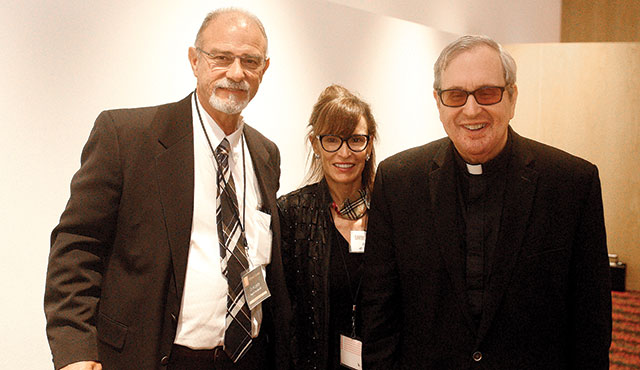With 300 guests packing Freed Theater and over 1,700 viewing Christ Cathedral’s Facebook livestream, the Oct. 4 event, “Science and the Shroud,” showed modern audiences still find the subject in question a most compelling artifact. That would be the Shroud of Turin, the famous linen cloth that bears the haunting frontal and dorsal image of a male figure who appears to have been crucified.
The Shroud has long been the subject of controversy. The “Science and the Shroud,” hosted by the Diocese of Orange, featured a keynote by Fr. Robert J. Spitzer, S.J., president of the Magis Center, and a presentation by Joseph Marino. Marino, a former Benedictine monk and veteran researcher of the Shroud, detailed new scientific findings on the old fabric.
“Young people are leaving the Church because they believe that science disproves religion,” said Hank Evers, director of marketing for the Diocese of Orange. “These talks shattered that belief as historical, medical, archaeological, artistic and geographic information found on the Shroud continues to come to light.”
In 1988, a carbon-14 dating test was conducted on about 7 centimeters of a corner piece of the 14-foot linen cloth. Samples submitted for C-14 testing are not salvageable, and the sample was burned in testing by three labs. It was concluded that the age of the harvested flax that produced the linen was dated between 1260-1390 AD. It was declared a medieval forgery, something not entirely out of the realm of possibility given the prominence of relics populating Christendom in the Middle Ages.
“Many people may be dissuaded by the dating, but new data overwhelmingly shows that the same used for this carbon dating was flawed,” Fr. Spitzer noted. In 2000, Marino and Sue Benford published “Evidence for the Skewing of the C-14 Dating of the Shroud of Turin Due to Repairs.” The central thesis of Marino and Benford’s findings was the presence of cotton fibers and dye interwoven in the area of the Shroud taken for the radiocarbon test. This suggests, Marino concluded, a highly specialized technique known as invisible reweaving technique was performed at some point in an attempt to repair the Shroud.
History has shown there was, in fact, a need for such a repair. A 1532 fire in the location the Shroud was currently being held, Chambery, significantly damaged the cloth. Poor Clare nuns painstakingly repatched it, most notably in the unmistakable parallel scorch marks that bookend the image on the Shroud. In his presentation, Marino noted a comment made by Piero Savarino, scientific adviser to Cardinal Poletto, former archbishop of Turin, who thought the C-14 results might have been mistaken due to “extraneous thread left over from ‘invisible mending’ routinely carried out in the past on parts of the cloth in poor repair.”
Fr. Spitzer also noted Marino and Benford’s findings were later thermochemically confirmed and documented by the late Dr. Raymond Rogers, leading world expert in thermochemistry.
Then, just this year, an unexpected paper was published in the peer-reviewed journal “Archaeometry.” Titled “Radiocarbon Dating of the Turin Shroud: New Evidence from Raw Data,” four researchers obtained the previously unreleased raw data of the C-14 testing kept in the British Museum through a Freedom of Information Act (FOIA) request. After putting the data through statistical analysis, the researchers concluded “homogeneity is lacking in the data and that the procedure should be reconsidered.”
This paper, fundamentally questioning the veracity of the 1260-1390 dating, countered a 2018 paper from the “Journal of Forensic Sciences” that analyzed the blood flow seen on the figure’s arms using Bloodstains Patterns Analysis techniques (BPA). The researchers of this analysis concluded the blood patterning was not realistic to the position of one crucified.
However, decades earlier a longtime analyst of the Shroud, Giulio Ricci, believed the forearm blood markings were not caused by nails from crucifixion but rather were wounds due to scourging.
Meanwhile, Fr. Spitzer has been tantalizing audiences with his analysis of the compelling features of both the linen cloth and the image on it. In light of the analysis presented at the “Science of the Shroud” event, Spitzer believes “a new carbon dating, following strict protocols to gather samples from different parts of the cloth must be performed.”
“Fr. Spitzer reminded me of an expert attorney,” Evers said. “It was as if he was making a closing argument, adding to and building up his evidence to make an almost overwhelming point: the Shroud of Turin is the real deal.”
Evers believes the fascination with the Shroud is a great conversation starter. “This is a story to share and one that can make a huge difference to the evangelization efforts of all Christians,” Evers said.
“It is quite probable that the new test will reveal an early origin of the Shroud around the 1st century,” Spitzer said.


